
A polar bear keeps close to
her young along the Beaufort Sea coast in Arctic National Wildlife
Refuge, Alaska. Only two out of 80 cubs monitored in the region survived
in 2004-2006: photo by Reuters via the Guardian, 17 November 2014
Polar bear population in frozen sea north of Alaska falls 40% in 10
years: Amanda Holpuch, The Guardian, 17 November 2014
The
number of polar bears inhabiting a frozen sea north of Alaska declined
by about 40% from 2001 to 2010, according to a report published on
Monday.
US Geological Survey researchers and scientists from Canada and the
United States found that bear survival rates in the south Beaufort Sea
were particularly low from 2004 to 2006, when only two of 80 cubs
monitored were known to have survived.
Bears overall fared better than juvenile bears in the study. Overall
survival rates began to climb in 2007, but survival of juvenile bears
declined throughout the 10-year study period. The bear population was
approximately 900 in 2010, the study’s final year.
Scientists said that the low survival rates could be caused by a low
seal abundance and limited access to seals in the summer and winter
months. Winter ice has become more thin and increasingly mobile over the
past few decades, leading it to break more frequently, creating “rough
and jumbled” ice conditions that are thought to make it more difficult
for bears to capture seals.
“The low survival may have been caused by a combination of factors
that could be difficult to unravel, and why survival improved at the end
of the study is unknown,” said Jeff Bromaghin, a USGS research
statistician and lead author of the study, in a statement.
The Polar Bear Specialists’ Group of the International Union for the Conservation
of Nature has been tracking polar bear populations globally. The group
will measure the new figures against global historic and current trends.
Dr Steven Amstrup, chief scientist at Polar Bears International, said
he spent most of his adult life working with this population of bears
and was “pained” to see the decline in the population.
“In 2007, my colleagues and I predicted we could lose polar bears
from the southern Beaufort Sea by the middle of this century if we
didn’t get on to a different greenhouse gas emissions path,” said
Amstrup. “This report confirms we still are on the wrong path.”

A polar bear keeps close to her young along the Beaufort Sea coast in Arctic National Wildlife Refuge, Alaska. Only two out of 80 cubs monitored in the region survived in 2004-2006: photo by Reuters via the Guardian, 17 November 2014

This handout photo provided by the US Geological Survey, taken in 2005, shows a male polar bear approaching biologists in Beaufort Sea, Alaska. A new U.S.-Canada study says a key polar bear population fell nearly in half in the past decade, with scientists seeing a dramatic increase in young cubs dying. Researchers chiefly blame shrinking sea ice from global warming. Scientists from the US Geological Survey and Environment Canada tagged and released polar bears in the southern Beaufort Sea from 2001 to 2010. The bear population shrank to about 900 in 2010, down from about 1600 in 2004: photo by AP / Steven C. Amstrup, USGS via The Guardian, 17 November 2014
This handout photo provided by the US Geological Survey, taken in 2005
shows Steve Amstrup holding triplet polar bear cubs in Prudhoe Bay,
Alaska. A new U.S.-Canada study says a key polar bear population fell
nearly in half in the past decade, with scientists seeing a dramatic
increase in young cubs dying. Researchers chiefly blame shrinking sea
ice from global warming. Scientists from the U.S. Geological Survey and
Environment Canada tagged and released polar bears in the southern
Beaufort Sea from 2001 to 2010. The bear population shrank to about 900
in 2010, down from about 1600 in 2004. their mother was being processed
for satellite collar tagging, weight, temperature, measurement, and
other observations: photo by AP / USGS via Polar Bears International, 17 November 2014
Is there still hope for polar bears and the Arctic?: photo by Kt Miller via Polar Bears International @PolarBears, 6 December 2014
Polar bears need you to #ACTONCLIMATE & SAVEOURSEAICE!: photo by Kt Miller via Polar Bears International @PolarBears, 6 December 2014
Research shows #polarbear pop. in AK & CA has declined 40% since new millennium: photo by Emily Ringer via Polar Bears International @PolarBears, 9 December 2014

Polar bears (pictured, an animal in Manitoba, Canada) as a species are considered vulnerable to extinction: photo by Paul Souders / Corbis via Natjional Geographic, 19 November 2014
Polar Bear numbers are plummeting dangerously: Linda Qiu, National Geographic, 19 November 2014
A large population of polar bears in Alaska and Canada has decreased by 40 percent since the start of the new millennium, new research shows. The number of the large predators living in the southern Beaufort Sea plummeted from 1,500 animals in 2001 to just 900 in 2010, according to the study, published in the journal Ecological Applications.
But there’s a lot we don’t know about the 18 other known polar bear populations, which are scattered throughout the U.S., Canada, Russia, Greenland, Norway and Denmark, experts say. Of the most studied populations, four -- including the southern Beaufort group -- are declining, five are stable, and one, in north-central Canada’s M’Clintock Channel, is actually increasing, scientists say.
The species as a whole is decreasing in number, and is listed as vulnerable by the International Union for the Conservation of Nature. The reason for the variability in numbers is location.
A large population of polar bears in Alaska and Canada has decreased by 40 percent since the start of the new millennium, new research shows. The number of the large predators living in the southern Beaufort Sea plummeted from 1,500 animals in 2001 to just 900 in 2010, according to the study, published in the journal Ecological Applications.
But there’s a lot we don’t know about the 18 other known polar bear populations, which are scattered throughout the U.S., Canada, Russia, Greenland, Norway and Denmark, experts say. Of the most studied populations, four -- including the southern Beaufort group -- are declining, five are stable, and one, in north-central Canada’s M’Clintock Channel, is actually increasing, scientists say.
The species as a whole is decreasing in number, and is listed as vulnerable by the International Union for the Conservation of Nature. The reason for the variability in numbers is location.
The
southern parts of the polar bear’s range, such as the southern Beaufort
Sea, are warming faster than the northern regions and are thus more
susceptible to melting sea ice.
As the ocean heats up due to global warming, Arctic sea ice has been locked in a downward spiral. Since the late 1970s, the ice has retreated by 12 percent per decade, and the decline has worsened since 2007.
It’s not surprising that the southern Beaufort Sea and its bears are feeling the effects first and more dramatically than those in more northern areas, said Ian Stirling, a biologist at the University of Alberta, in Edmonton, who is studying climate change’s impact on polar bears.
Polar bears in this region are declining because they use sea ice as hunting platforms to catch their primary prey, seals. But “when that ice is there, it’s really jumbled up,” said study leader Jeff Bromaghin, a U.S. Geological Survey statistician who studies wildlife population dynamics.
As the ocean heats up due to global warming, Arctic sea ice has been locked in a downward spiral. Since the late 1970s, the ice has retreated by 12 percent per decade, and the decline has worsened since 2007.
It’s not surprising that the southern Beaufort Sea and its bears are feeling the effects first and more dramatically than those in more northern areas, said Ian Stirling, a biologist at the University of Alberta, in Edmonton, who is studying climate change’s impact on polar bears.
Polar bears in this region are declining because they use sea ice as hunting platforms to catch their primary prey, seals. But “when that ice is there, it’s really jumbled up,” said study leader Jeff Bromaghin, a U.S. Geological Survey statistician who studies wildlife population dynamics.
“The seals may be there, but the polar bears can’t get to
them.”
In 2007, the U.S. Geological Survey estimated that the global polar bear population will shrink to a third of its current size by 2050, due to loss of and less access to prey.
In 2007, the U.S. Geological Survey estimated that the global polar bear population will shrink to a third of its current size by 2050, due to loss of and less access to prey.
“Nothing in this study contradicts the 2007 estimates,” said Bromaghin.
“Actually, observed loss of sea ice in the Arctic has been greater than earlier climate models.”
Faced with a less icy Arctic, some polar bears appear to be coping on land, in part by adding snow goose eggs and caribou to their diet. For a species that needs fat-rich, energy-dense foods, though, a diverse palate might not be enough, according to Bromaghin.
“Sure, they’re starting to use land when food sources are limited. They’ll eat whatever they can catch. But it’s not enough to sustain them in the long run,” he said. “Every scrap of evidence suggests that polar bears are linked to sea ice. There’s no evidence they can live on land.”
Faced with a less icy Arctic, some polar bears appear to be coping on land, in part by adding snow goose eggs and caribou to their diet. For a species that needs fat-rich, energy-dense foods, though, a diverse palate might not be enough, according to Bromaghin.
“Sure, they’re starting to use land when food sources are limited. They’ll eat whatever they can catch. But it’s not enough to sustain them in the long run,” he said. “Every scrap of evidence suggests that polar bears are linked to sea ice. There’s no evidence they can live on land.”
The fate of the species also remains unclear because so little is known
about the understudied populations in the high Arctic, Utah State’s
Koons noted.
Those bears may be in similarly dire straits, but it’s just
undocumented, says the University of Alberta's Stirling.
“The fundamental concept is simple,” he
said. “As we continue to lose ice, particularly during key feeding
periods, numbers of polar bears will decline.”
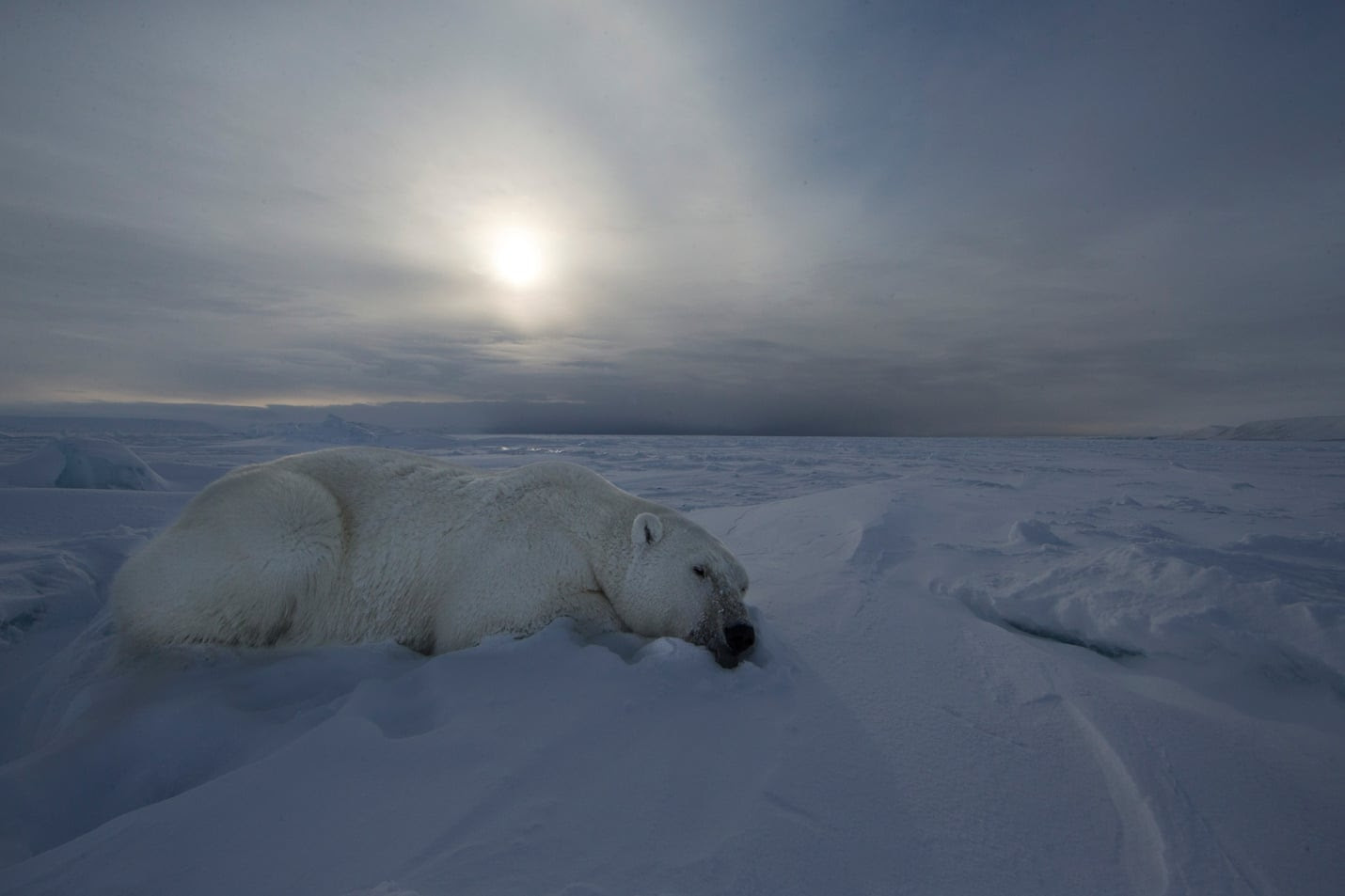
Rising temperatures and increasing ice melt are transforming the island’s of Svalbard in Norway’s high arctic. The WWF-Canon and Norwegian Polar Institute Arctic research expedition 2014 looks at how the polar bear population is adapting to the effects of climate change. One of the big threats for polar bears today is the effect of climate change. Polar bears don’t live in the centre of the Arctic, by the North Pole; they live along the edges of the ice, where they can find seals. They depend on sea ice, on which they can hunt seals, rest and breed. Due to the warming climate, summer ice continues to decrease and is also melting for a longer period, preventing polar bears from going out to get food. They must swim or walk longer distances to keep track with the shrinking ice: photo by Brutus Östling / WWF-Canon via The Guardian, 9 December 2014

The researchers not only earmark, but also weigh the bears, if possible. This
female, weighing only 90kg, had lain down gently with her head on her
arm and seemed to sleep very calmly after being tranquilised to enable
the researchers to approach her: photo by Brutus Östling / WWF-Canon via The Guardian, 9 December 2014
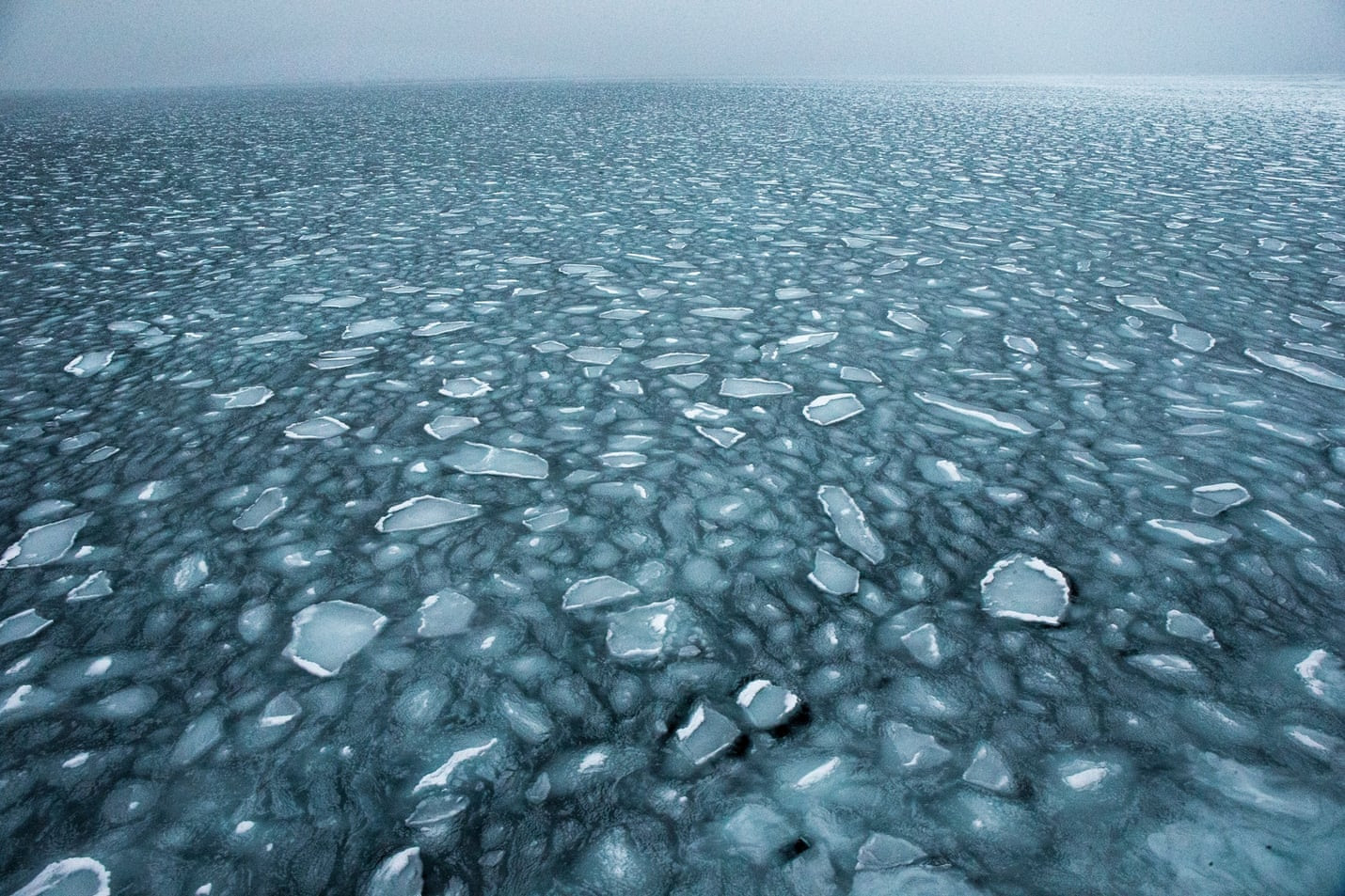
The
decrease in ice seems to have led the female polar bears into seeking
new denning areas, as old sites are now impossible to reach or no longer
exist. One
of the objectives of the WWF-Canon expedition was to locate new denning
sites and find out if they are proving successful for the polar bears.
However, this year the researchers only found one functioning den with
cubs. Conclusions shouldn’t be drawn just yet, but by repeating the
research, patterns will emerge and it will be possible to judge how
climate change may affect the polar bear’s denning: photo by Brutus Östling / WWF-Canon via The Guardian, 9 December 2014

A female sleeping before researchers start their work of weighing and earmarking her, taking skin tissue and blood samples. By looking at her teeth, they estimated her age to be 15-16 years old. Even though she weighed only 90kg, she would gain weight quickly if she found a stranded whale for example: photo by Brutus Östling / WWF-Canon via The Guardian, 9 December 2014

Glacier ice differs from the sea ice as it is old ice. Glaciers consist of layers and layers of snow that has fallen over thousands of years. Just like sea ice, glaciers are melting during Summer. But while sea ice usually disappears completely around Svalbard, the glaciers tend to melt just a little bit; however, today some glaciers are decreasing very rapidly due the climate change: photo by Brutus Östling / WWF-Canon via The Guardian, 9 December 2014

This tranquilised young cub slept peacefully next to his mother. A one year old cub like this weighs about 90kg and could be dangerous: photo by Brutus Östling / WWF-Canon via The Guardian, 9 December 2014

The polar bear stands as a symbol for the work needed to save this very special Arctic environment. There are an estimated 25,000 polar bears left in the world, although the species is considered to be vulnerable. It is becoming more and more vulnerable as climate change continues and as the pack ice is decreasing: photo by Brutus Östling/WWF-Canon via The Guardian, 9 December 2014

A polar bear (Ursus maritimus) running on ice floe in Reinsdyrflya, Svalbard, Norway. Ice floes are crucial for bears’ survival but becoming rare in the Arctic ocean. A new DNA technology, however, could help track the plight of endangered species: photo by Daisy Gilardini / Getty Images via The Guardian, 5 September 2014
A White Bear
My father took a single turn across the room, then sat down and finished the chapter.
The verbs auxiliary we are concerned in here, continued my father, are, am; was; have; had; do; did; make; made; suffer; shall; should; will; would; can; could; owe; ought; used; or is wont.---And these varied with tenses, present, past, future, and conjugated with the verb see,--- or with these questions added to them;---Is it? Was it? Will it be? Would it be? May it be? And these again put negatively, Is it not? And these again put negatively, Is it not? Was it not? Ought it not?---Or affirmatively,---It is; It was; It ought to be. Or chronologically, Has it been always? Lately? How long ago? Or hypothetically,---If it was? If it was not? What would follow?---If the French should beat the English? If the Sun go out of the Zodiac?
Now, by the right use and application of these, continued my father, in which a child's memory should be exercised, there is no one idea can enter his brain how
barren soever but a magazine of conceptions and conclusions may be
drawn forth from it.----Didst thou ever see a white bear? cried my
father, turning his head round to Trim, who stood at the back of
his chair:---No, an'please your honour, replied the corporal.-----But
thou could'st discourse about one, Trim, said my father, in case of need?----How is it possible, brother, quoth my uncle Toby, if the corporal never saw one?-----'Tis the fact I want; replied my father,---and the possibility of it, is as follows:
A WHITE
BEAR! Very well. Have I ever seen one? Might I ever have
seen one? Am I ever to see one?
Ought I ever to see one?
Or can I ever see one?
Would I had seen a white bear! (for how can I imagine it?)
If I should see a white bear, what should I say? If I should
never see a white bear, what then?
If I never have, can, must or shall see a white bear alive;
have I ever seen the skin of one?
Did I ever seen one painted?---described?
Have I ever dreamed of one?
Did my father, mother, brothers or sisters, ever see a white
bear? What would they give? How would they behave? How would
the white bear have behaved? Is he wild? Tame? Terrible?
Rough? Smooth?
---Is the white bear worth seeing?---
---Is there no sin in it?---
---Is it better than a BLACK ONE?
Laurence Sterne: from The Life & Opinions of Tristram Shandy, 1760 (Volume V, Chapter XLIII)
Polar Bear (Ursus maritimus), Arctic National Wildlife Refuge, Alaska: photo by Alan D. Wilson, 2007
Polar Bear (Ursus maritimus), Alaska: photographer unknown, n.d. (U.S. Fish & Wildlife Service)
Polar Bear (Ursus maritimus) at Cape Churchill, Wapusk National Park, Manitoba, Canada: photo by Ansgar Walk, 2004

Three Polar bears approach the starboard bow of the Los Angeles-class fast attack submarine USS Honolulu (SSN 718) while surfaced 280 miles from the North Pole. Sighted by a lookout from the bridge (sail) of the submarine, the bears investigated the boat for almost 2 hours before leaving. Commanded by Cmdr. Charles Harris, USS Honolulu while conducting otherwise classified operations in the Arctic, collected scientific data and water samples for U.S. and Canadian Universities as part of an agreement with the Arctic Subarine Laboratory (ASL) and the National Science Foundation (NSF). USS Honolulu is the 24th Los Angeles-class submarine, and the first original design in her class to visit the North Pole region. Honolulu is assigned to Commander Submarine Pacific, Submarine Squadron Three, Pearl Harbor, Hawaii: photo by Chief Yeoman Alphonso Braggs, US Navy. 11 October 2013 (US Navy)
A polar panorama, Svalbard, Norway, 2005: Paul Hermansen had seen many polar bears in the vast, icy Arctic landscapes. But this bear was in the most breathtaking setting he had ever seen. His expedition vessel got as close as 15 metres. Hermansen waited until the bear lifted its head from its meal of ringed seal and then took a series of shots as a panoramic stitch. The result is a magnificent polar panorama that tells the story of nature and offers multiple interpretations, including that of climate change thinning the Arctic ice and literally shrinking the dinner table of polar bears: photo by Pal Hermansen/The Masters of Nature Photography/Natural History Museum via The Guardian 5 September 2013

Un ours blanc (Ursus maritimus) bondissant entre deux blocs de glace de la banquise fondante, sur l'île de Spitzberg, dans l'archipel norvégien de Svalbard: photo by Arturo de Frias Marques, 17 July 2011
Mothers
and cubs have high nutritional requirements, which are not met if the
seal-hunting season is too short. Ursus maritimus Polar bear with cub: photo by Scott Schliebe; image by Clayoquot, 7 May 2008 (US. Fish & Wildlife Service)

Melting ice is cutting polar bears off from their food source in Hudson
Bay, and death rates have soared: photo by Paul J. Richards/AFP via The Guardian, 6 August 2014
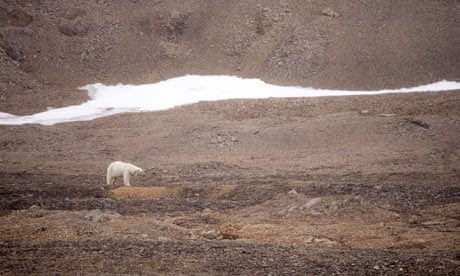
Scientists are tracking polar bears with radio collars in Svalbard, Norway, to monitor their search for food: photo by Ashley Cooper/Global Warming Imagesvia The Guardian, 6 August 2014

This 16-year-old male polar bear died of starvation resulting from the lack of ice on which to hunt seals, according to Dr Ian Stirling, who has studied polar bears for almost 40 years with the Canadian Wildlife Service and the University of Alberta: photo by Ashley Cooper/Global Warming Images via The Guardian, 6 August 2013

Retreating pack ice, Svalbard archipelago, Norway: photo by Ralph Lee Hopkins via the Guardian, 10 November 2014

Polar bear (Ursus maritimus) on pack ice, Svalbard archipelago, Norway: photo by Ralph Lee Hopkins via the Guardian, 10 November 2014

A mother polar bear and her two cubs traverse the ice in Nunavut, Canada, September 2014: photo by Justin Hofman/Barcroft Media via the Guardian, 10 November 2014

A mother polar bear and her two cubs traverse the ice in Nunavut, Canada, September 2014: photo by Justin Hofman/Barcroft Media via the Guardian, 10 November 2014


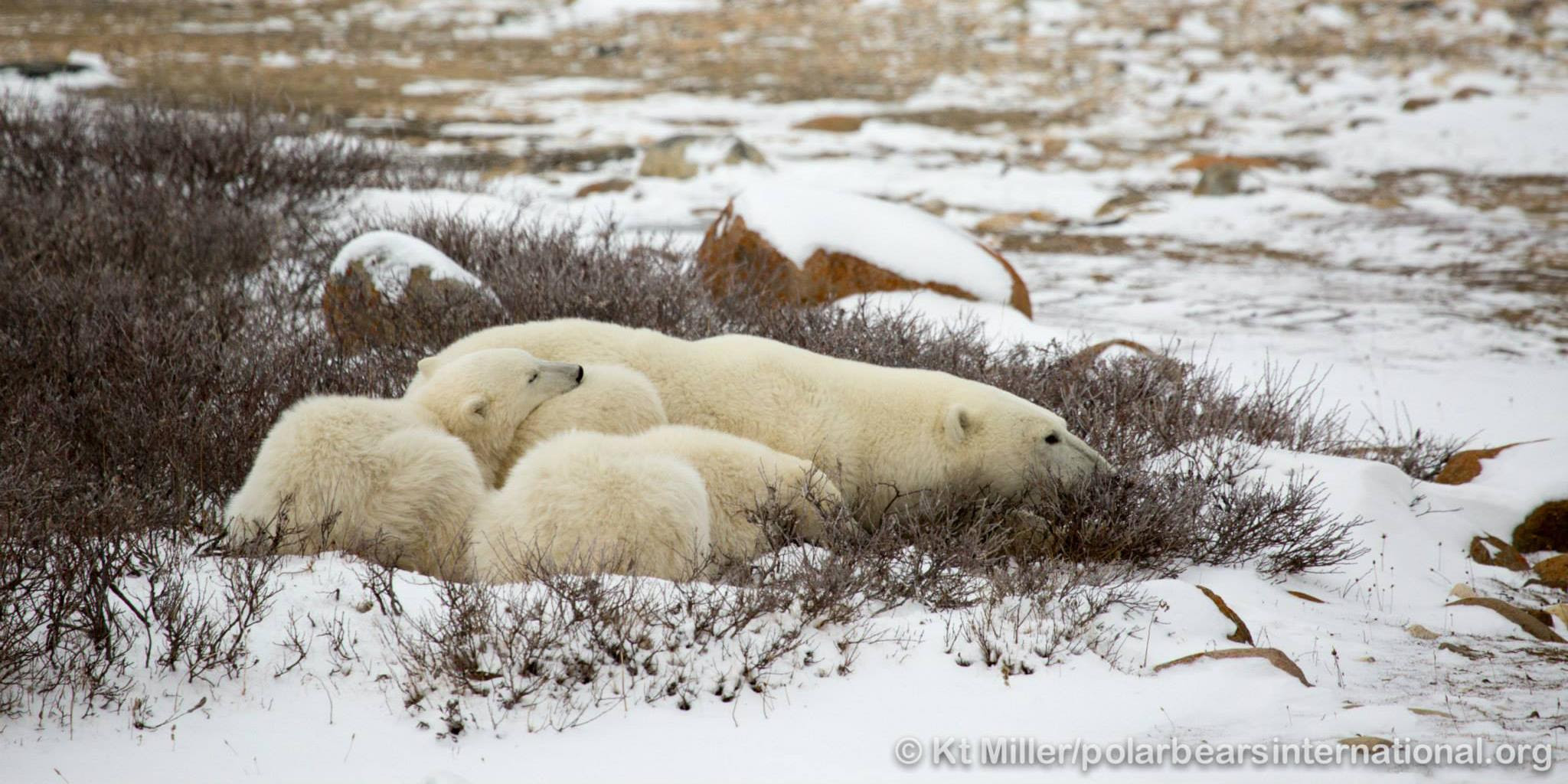



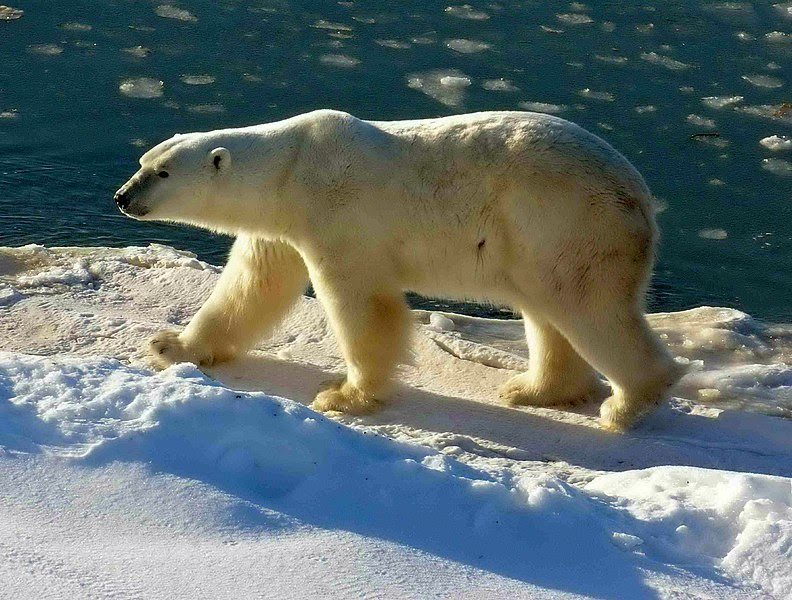
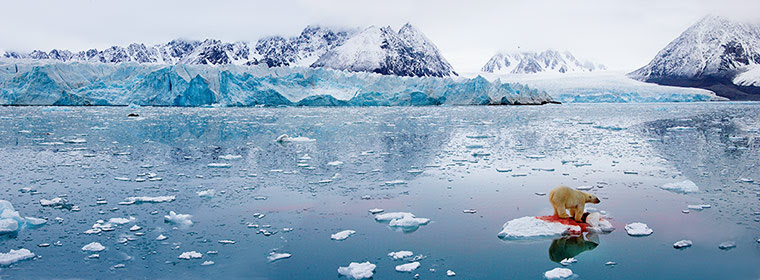




4 comments:
another great post Tom, the Sterne lines especially poignant somehow...tragic shit...
Michael,
Yes, the historical Human Comedy that began around the time History began -- that is, a few thousand years ago -- now appears to be something else altogether, a true tragedy, not of course for the human perpetrators who have made themselves immune to the natural world by abandoning/exterminating it, but for the grand, beautiful abundance and diversity of life with which this planet was gifted long before the tiny pathetic lead actor arrived, in an SUV, to pull the curtain down on everything but himself. Oh, and yes, his smartphone.
(I understand, by the way, Google is now working on a smartphone which you can flush down the toilet with a nuclear weapon attachment, and while swirling, it will correct its own angle of descent, right itself, perform its own hazardous materials cleanup, conduct a bit of impromptu offshore drilling, provide stock tips and coordinates for a quick trip to pick up something at Walmart, and be back safely in your pre-selected-by-drone-individually-for-you cryogenic cube hotel in time to tune into the live feed from the Beaufort Sea, as the last polar bear is antiseptically neutralized... er, would the proper term be starved to death in the name of Progress, or perhaps simply cooked?)
The image of the starved bear is heartbreaking.
It will be our tragedy too, at least for those of us at the wrong end of the social spectrum.
Still, never mind, eh?
More and more it seems here that the tragedy has to do with the animals, our part of the pageant now reduced to pathos and bad comedy.
For example... the idiot giddiness of that Disney animated cutie, Frozen virtually crying out for a revised ending.
(One wanted to see live footage of the "Weatherbomb" hitting Prestwick and turning the cartoon fetishes into flavoured ices on a stick.)
Post a Comment